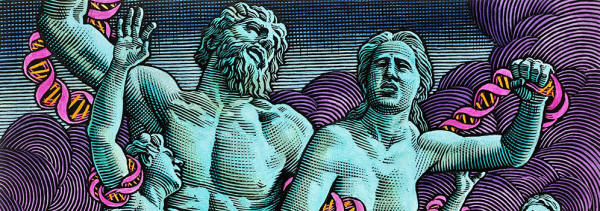All life on Earth exists thanks to a universal genetic code.
This biological rulebook tells our cells how DNA should be translated into life-supporting proteins, without which we couldn't survive.
Even though the genetic code commands a seemingly immeasurable number of organisms, it also binds us all together as descendents of a shared ancestor - a lingua franca for 'life.'
Yet for all of its diverse and essential properties, the genetic code is static.
For some reason unknown to scientists, approximately 3 billion years ago it simply stopped growing. Instead of expanding to encode new combinations of amino acids, and potentially new life, it stagnated at its current size and function.
But a new study (Saturation of Recognition Elements Blocks Evolution of New tRNA Identities) published today in the journal Science Advances offers an explanation for the genetic code's mysterious evolutionary limit.
A team of geneticists from the Institute for Research in Biomedicine and the Centre for Genomic Regulation discovered that several billion years ago, the genetic code reached a point of self-preservation.
Namely, it could continue evolving and risk mutating the building blocks of life it was responsible for creating, or it could remain limited, albeit functional.
"Protein synthesis based on the genetic code is the decisive feature of biological systems and it is crucial to ensure faithful translation of information," the study's lead author, Lluís Ribas de Pouplana, said in a statement.
The origin and expansion of the genetic code occurred long before the split of the three domains of life:
bacteria
eukaryotes
archae
And it wasn't until the 1960s that scientists were finally able to unlock its fundamental structure.
But for all the potential it held to engineer brand new lifeforms, the genetic code has been relatively uncreative.
Over millennia, the genetic code evolved to contain "codons" of three nucleotides, which transfer RNA (tRNA) translate into a 20-letter chain of amino acids, leading to the creation of basic proteins.
However, at some point in history, transfer RNA hit a functional limit to the number of amino acids it was able to successfully interpret into proteins, the study found. It was at that point the genetic code, and the complexity of organic life, stood relatively still.
Any more than 20 amino acids, and the machinery of gene expression got confused.
The results of such erroneous translation were constant mutations,
"with catastrophic consequences," according to Ribas.
While the expansion of the genetic code allowed for new tRNA creation, the particular L-shaped cavity of ribosomes - the part of the cell where protein is actually constructed - ultimately allowed for very little variation.
If tRNA molecules didn't adapt to accommodate the specific needs of the ribosome, the efficiency of protein synthesis would be vastly compromised, and fatal for life.
"There came a point when nature was unable to create new tRNAs that differed sufficiently from those already available without causing a problem with the identification of the correct amino acid.
And this happened when 20 amino acids were reached," Ribas explained.
The study's authors hope their findings can be applied in the field of synthetic biology, and allow for exciting breakthroughs in gene manipulation efforts.
Right now, a novel gene-editing technique called CRISPR/Cas9 is gaining momentum due to its ability to meticulously modify DNA with better results than those of other contemporary technology.
And it's possible that insights regarding the genetic code's evolution and limitations could help biologists create unique proteins with entirely new functions.
Explorations into both primordial history and our genetically altered future can open the door for exciting innovations in the field of genetics. Evolution's successes and failures can tell us more about our tenure as a species than any science-fiction manifesto.
But most importantly, if we don't look back every so often, we'll never know how far we've actually come.


